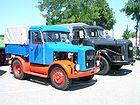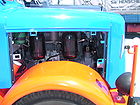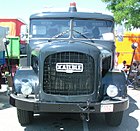Kaelble
The German company Kaelble from Backnang was a construction machinery , engine and commercial vehicle manufacturer and was best known for its tractors for road scooters , dump trucks and bulldozers . From 2002 Kaelble was a division of Terex GmbH under the name TEREX-Kaelble . In 2010 Atlas Maschinen GmbH took over all of the Kaelble shares.
Emergence
The company was founded in Cannstatt in 1884 as a repair workshop for tannery and steam engines by Caroline and Gottfried Kaelble. Five years after moving from Cannstatt to Backnang in 1895, machine production began. The designer was the son Carl Kaelble, one of eleven children in the family. In 1905 the production of self-propelled stone crushers began and in 1907 Gottlieb Kaelble and his two sons Carl and Hermann built the first truck with a self-developed engine on a stone crusher chassis. The truck was used for its own company transport. From 1908 motorized road rollers were built and the company became a general partnership . After the death of his father Gottfried Kaelble, Carl Kaelble took over the management in 1911. As early as 1912, the first takeover was 100% with the Carl Metz machine factory , a well-known manufacturer of fire engines. The company remained independent and became "Carl Metz GmbH". During the First World War, especially heavy were tractors for artillery built.
The permanent entry into commercial vehicle construction with heavy tractors began in 1925. With the "Z1", Kaelble presented the world's first diesel tractor. Carl and Hermann Kaelble founded " Gmeinder & Co. GmbH" with Anton Gmeinder, based in Mosbach . On January 1, 1931, "Carl Kaelble OHG" was converted into a GmbH . When the Deutsche Reichsbahn began delivering freight cars with road scooters to customers without a siding in 1933 , Kaelble became the house supplier of the required tractors. The company delivered its first three-axle tractor unit in 1933, the Kaelble type “Z6R” tractor. Powerful tractors were required to transport the wagons with the road scooter developed by Johann Culemeyer ; Kaelble developed and built these as required for the Deutsche Reichsbahn, but also for private companies. Kaelble built tractors such as the “Z4GR”, “Z6RL / Z6R2A100”, “Z6R” and the Z6R3A for the heavy transport sector of the Deutsche Reichsbahn . The express tractors “Z3” and “Z4GR” for inner-city traffic were also known in the pre-war period. The Kaelble S6R semitrailer tractor delivered in 1935 was specially made for the DRG's wagon transport. Kaelble also offered agricultural tractors such as the “Z3A” or tractors for transporting logs such as the “ZK3” or “ZK4”.
At the end of 1936, Kaelble brought the first truck in the 6.5 ton vehicle class onto the market with the “6.5L” type; its gross vehicle weight was 13,000 kg. For the private industry, so-called "express tractors" were offered with a speed of up to 40 km / h. These were also used by the DRG for their transport of large containers for “door to door” traffic. The Kaelble tractors of the type "Z6G125" and "Z6GN125" were used for this. From 1935, the aircraft tractor “Z2S” and the tractor unit “Z6Wa” with a 100 hp engine were produced for the Air Force. This Kaelble tractor based on the Z6GN110 was equipped with two seats in the rear, the so-called convertible seats. The "SS6GN110" and "SS6GN125" tractor units were built for the Navy. Starting in 1939, the "Z6W2A130" tractor with an output of 130 hp and two open seats at the rear of the vehicle were produced for the Wehrmacht.
From 1939 the product range was expanded to include bulldozers , starting with the "PR125" caterpillar. The Kaelble PR125 was the largest bulldozer produced in Europe at the time, it had a Kaelble GN125s engine that developed 130 hp. From 1941 the company had to produce exclusively for the German armed forces. Vehicles for private companies or the Deutsche Reichsbahn were only produced on allocation.
After the death of Anton Gmeinder in 1942, Kaelble took over the joint company completely. The second takeover of a company resulted in Carl Kaelble GmbH now running two independent sister companies: Carl Metz GmbH and Gmeinder & Co. GmbH .
After 1945
After the Second World War, the construction of tractors, bulldozers, trucks and dump trucks started again. The Kaelble PR630 bulldozer was developed as the successor to the PR125 as early as 1951, and in 1952 the PR610 was developed together with the Gmeinder company . The Kaelble-Gmeinder PR610 initially had a Kaelble-GN110s engine with 100 hp. From 1952 two- and three-axle dump trucks were also manufactured. In particular, dump trucks like the "KV 34", "KVW 34" and "K20" are known. The trucks offered by Kaelble, such as the K630K, K631L, K832L, KDV836E, were only produced in small numbers compared to large manufacturers in this area such as Henschel , Magirus-Deutz , MAN and Mercedes-Benz . The Deutsche Bundesbahn also obtained its tractor units from Kaelble until the road scooter operation was discontinued in 1987, for example the "K631", the "KV633ZB" and the "KV631ZRF". The last tractor units for the DB were delivered in 1971. The Deutsche Bundespost also obtained some vehicles for the telecommunications service from Backnang , such as the “K410”, “K612”, and the “KDV12Z6” tractors delivered in 1963.
As early as 1949, was Kaelble Frontlenker -Truck offered the K630LF with a 150-horsepower engine. In 1951 its successor came, a type "K631LF" forward control.
Due to the restrictive length and weight restrictions of the " Seebohm's Laws " of 1953, the Kaelble company lost its market niche for trucks in the transport industry, as these could no longer be used economically by customers. Although these restrictions were lifted or relaxed again in 1960, most of the company's regular customers had meanwhile switched to other manufacturers who had lighter models on offer. Since Kaelble did not have any light vehicles in its program, these had to be developed first. By 1962 finished cab- type K652LF the company wanted to regain a foothold in the truck market. However, the vehicle came too late to be successful and only 42 units were built up to and including 1963.
So it was decided at Kaelble to stop normal truck construction in 1963 and to concentrate on special vehicles and heavy-duty tractors from then on. After the end of truck production, Kaelble developed and built a completely new, angularly designed tractor generation. Two special vehicles were built for Carl Metz GmbH . When the highest turntable ladder in the world, the DL 60 + 2, was built by Carl Metz GmbH in 1957, it was mounted on a Kaelble three-axle model "KD680LF". The second vehicle with the same type of turntable ladder was delivered to Moscow on a Kaelble "KDV400z". In 1975 the Scheuerle company received an order from a Turkish electricity company to develop a transport system for transformers. The tractors required were built by Kaelble; these four-axle tractors of the type "K4VW615Z" developed 615 hp and had a technically possible total weight of 45,000 kg. A total of eight units were built for this order by 1984.
In 1976 the Schad family, partial shareholders of Kaelble GmbH, took over Carl Metz GmbH in exchange for their Kaelble and Gmeinder company shares . In 1977 Kaelble received a major order from the Libyan army for 250 heavy three-axle tractors for tank transporters. For this order, front control vehicles of the type "KDVW400S" and "KDVW500S" were built. The low loaders were supplied by the Scheuerle company. This major order led to the neglect of the other business areas and to the loss of new orders and market share. The resulting financial problems could only be solved by selling shares to the Libyan investment company Libyan Arab Foreign Investment Company (Lafico). From 1979, Lafico gradually took over further shares in Kaelble GmbH and in 1983 became the main shareholder. In the same year 1983 the last road rollers were delivered. In 1984 the production of road tractors was completely stopped. From this point on, the company produced almost only wheel loaders and dump trucks and was therefore completely dependent on the construction industry and on the Great Man Made River project in Libya.
Due to the sales problems of construction vehicles, the merger with Gmeinder GmbH to form Kaelble-Gmeinder GmbH took place in 1986 . The company's problems also led to the production of bulldozers being discontinued and the property in downtown Backnang being sold.
insolvency
As a result of the Libya embargo, the company had to file for bankruptcy in 1996. The Gmeinder share was sold from the bankruptcy estate; the company Gmeinder Lokomotiv- und Maschinenfabrik GmbH was created, which continued the locomotive and gearbox construction. Kaelble Baumaschinen- und Reparaturgesellschaft mbH emerged from the Repairs and Spare Parts division . The company was later bought by Terex Deutschland GmbH ; The Terex-Kaelble , based in Backnang , was created, and high-performance wheel loaders were produced. With effect from August 17, 2010, Atlas Maschinen GmbH (Delmenhorst) purchased all of the commercial property rights and stocks of the Kaelble Loader business as part of the last addition to the transaction with Terex Corporation. Since August 2012 the company has been active again under the umbrella of Atlas Maschinen GmbH, Ganderkesee . However, production was outsourced to Bulgaria and continued there by the Bulgarian Industrial Group (BIG). There are currently two wheel loaders and an Atlas compact excavator in the production program.
In the former factory hall in Backnang, the Kaelble hall at Mühlstraße 13, a technology collection with exhibits from local industrial history is now housed. The production hall on the outskirts of Backnang on Maubacher Strasse, which was also used to the last to recondition used machines, fell victim to a major fire on April 6, 2006.
Product range
- Off-road vehicle (prototype)
- Self-propelled band saws
- Trucks
- Engines
- Dump truck
- Bulldozers
- Wheel loader
- Semi truck
- tractor
- Stone crusher
- Road rollers
- Tractors - off-road tractors , industrial tractors , heavy-duty tractors
Kaelble tractors can be viewed
- Railway Museum Darmstadt-Kranichstein : various road scooters and a Kaelble KV 633 ZB
- Railway Museum Bochum-Dahlhausen : restored Culemeyer road scooter R40 and Kaelble KV 632 ZB / 13
- Oldtimer Museum Rügen in Prora / Rügen: Street scooter with tank car and Kaelble K 633
Pictures of Kaelble tractors
See also
- History of the commercial vehicle industry
- Gmeinder GmbH
- Street scooter
- Kaelble Z6R3A
- Machine factory Carl Metz
- tractor
swell
- Wolfgang M. Gebhardt: The history of the German truck construction. Volume 1, p. 94, Volume 3 b, p. 49-64, Weltbild Verlag 1994 ISBN 3-89350-811-2 .
- Christian Suhr, Ralf Weinreich: German truck classics. Motorbuch-Verlag, Stuttgart 2007, ISBN 978-3-613-02718-3 , pp. 146–157.
- Udo Paulitz: Yesterday's Trucks - Today's Veterans. Franckh-Kosmos Verlag, Stuttgart 2001, ISBN 3-440-08582-1 .
- Culemeyer: The railroad into the house. Otto Elsner Verlagsgesellschaft, Berlin 1939.
- Joachim Wahl, Alexander Luig: Kaelble. Trucks and tractors. Podszun Verlag, Brilon 1999, ISBN 3-86133-207-8 .
- Erwin Fink: A Swabian company. History and background information from over 100 years of the Kaelble company in Backnang. Stroh Verlag, Backnang 2000, ISBN 3-927713-26-0 .
Web links
- Jens Merte: Gmeinder Lokomotiv- und Maschinenfabrik. In: werkbahn.de. (Information on company history and production figures).
- Mathias Bartels: Kaelble company from Gerabronn again under Terex umbrella. In: swp.de . June 13, 2015 .
Individual evidence
- ↑ Kaelble machines defied desert sand and heat. In: murrhardter-zeitung.de. December 24, 2010, archived from the original on August 8, 2016 ; accessed on August 25, 2019 .
- ^ Atlas takes over "Kaelble Loader" from Terex. In: NWZ Online . August 27, 2010, accessed August 25, 2019 .










